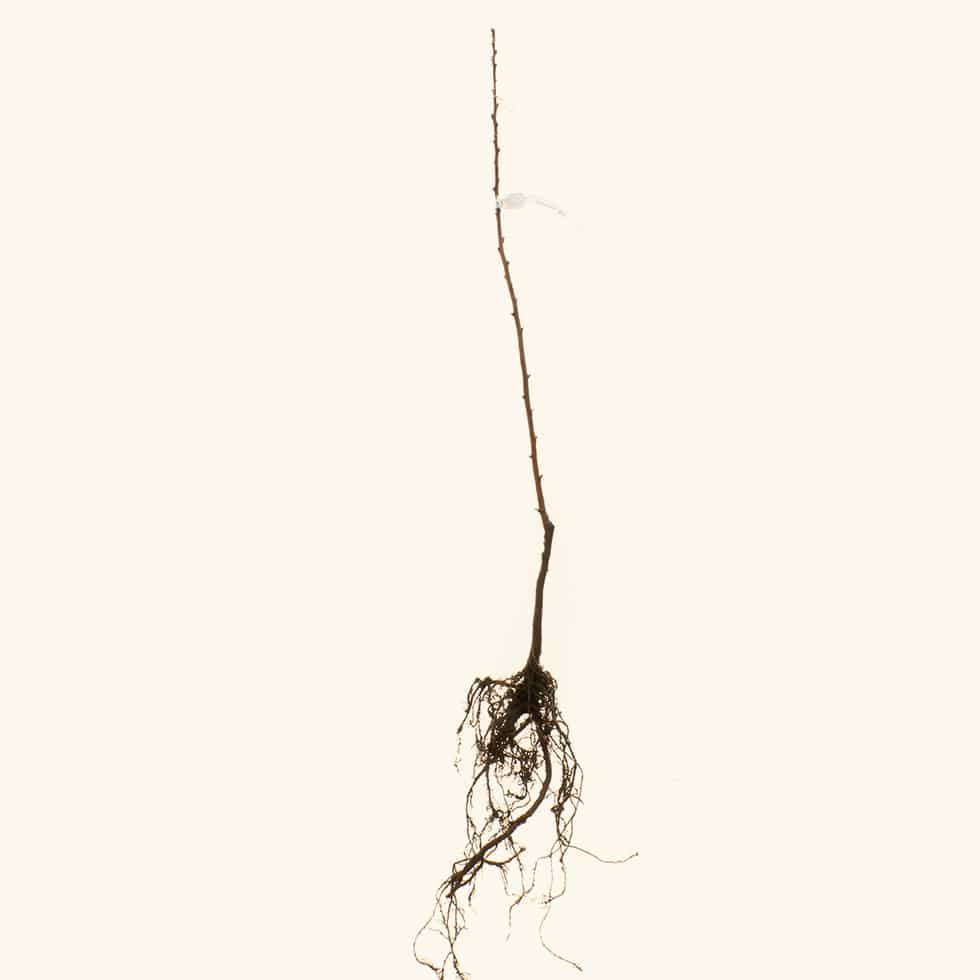Patterson Pride Plum Tree
- Zone 2Characteristics of the tree

Patterson’s Pride is of particular interest for its ‘weeping’ growth habit. This means that it tends to stay smaller than most plum trees. It gives bountiful harvests of excellent-quality plums.


Patterson Pride is a medium-sized red plum weighing about 24g on average. It is slightly oblong in shape, with soft and juicy orange flesh. The skin is thin, smooth and somewhat acidic, and the flesh is very sweet, exactly the taste you expect from a good plum. It measures 14.8 Brix at peak maturity.
The plum is semi-freestone, and while it is excellent for fresh eating, it would also work well in jams or canned in syrup (for the latter it would be better to harvest it a bit early, when it is still firm).
It is ready to harvest in late August or early September.
The Patterson Pride plum tree is remarkable for its weeping form, which renders it a ‘semi-dwarf’ plum tree that does not grow taller than about 4 metres (10 feet) in height.
This makes it particularly striking in appearance, and a good choice if you have limited space in your yard. It will definitely need to be staked during the first few years, however: otherwise its tendency to bend its branches means that it will not grow straight.
This plum tree is also a very productive bearer, and extremely hardy, growing in harsh climates up to zone 2b. Like most hybrid plum trees, it is self-sterile and requires a wild plum tree (Canada Plum or American Plum) for pollination.
Patterson Pride was selected by Dr. Cecil Patterson, to whom this variety owes its name, in 1946. Dr. Patterson was the first head of the Horticultural Department at the University of Saskatchewan, and played an important role in the development of many cultivars. In fact, for almost 18 years, his was a ‘one man department’ – he was single-handedly responsible for teaching classes on forestry, horticulture, beekeeping and other topics; as well as going on with research and breeding work with both fruit trees and vegetables, much of which he carried out at his home.
Not finding any resources on the cultivation of fruit trees in prairie conditions, he decided to write and self-publish possibly the first textbook ever written on the topic, called Hardy Fruits with Special Reference to their Cultivation in Western Canada. Clearly very much dedicated to making a world in which people could grow their own food and fruit; he invited anyone with questions about gardening to write to his department, offering to provide them with free access to books and advice. He was of the opinion that every homestead should have its fruit trees.
Patterson Pride, just one of his many creations, was introduced by the University of Saskatchewan in 1960. It’s an honour for us to propagate his legacy.
Plums are fast-growing trees, but stay relatively small. A plum tree at maturity will not usually exceed 5 metres or 16 feet in height. Its life expectancy is also quite short: one can generally expect it to live between 30 and 50 years. This illustration shows a 20-year-old plum tree that has attained its maximum height.
You should note that this illustration is meant only to give a general indication of what you can expect, and the growth of your tree might look somewhat different. The development of a tree depends on the soil type, irrigation, fertilisation and climatic conditions. What we show here is based on our observation of the growth of plum trees in zone 4, in rather poor soil. In zone 2, growth will probably be slower, while in a rich soil it could be faster.

All our plum trees are sold bare-root, without pots. They have been cultivated directly in our soil. Bare-root trees must be taken out of the ground and shipped during their period of dormancy, which is why we only ship trees in the spring. A big advantage with these kinds of trees, is that they take up very little space, and can therefore be easily shipped by mail all over Canada!
This photograph shows a 2-3-foot plum tree, just like one that you might receive. Depending on the height you choose at the time of purchase, the tree might be a little smaller (1-2 feet) or somewhat taller (3-5 feet.)

Our plum varieties are hybrids of Canadian, American and Japanese plums. If you are thinking of planting a plum tree, it is important to understand how their pollination works. Hybrid plum trees are self-sterile, and cannot produce fruit alone. Moreover, they are not good pollinators for one another. Even if you plant two different varieties next to each other, you are unlikely to harvest any fruit.
Instead, hybrid plum trees need a wild plum tree to pollinate them: either the Canada plum (Prunus nigra) which is considered the best pollinator, or the American plum (Prunus americana) which also works well. So if you intend to plant plum trees, you must also plant at least one of these nearby, unless of course you already happen to have one. One wild plum tree is enough to pollinate up to around five grafted plum trees.

One drawback of plum trees is that they tend to flower early, making them sensitive to freezing in late frosts. Some microclimates help to mitigate this, such as the proximity of a lake or ocean.
We also have a trick to help prevent them from flowering too early: applying a layer of mulch or compost underneath the base of the tree while there is still a good amount of snow on the ground. This insulates the snow underneath, so that it melts more slowly, and by maintaining a colder environment around the base of the tree, delays the start of its flowering period.


















